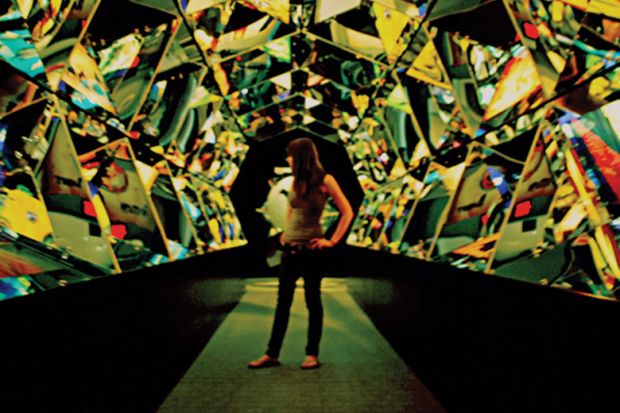I couldn’t help it: as I read these accounts by female Canadian scholars of marginalisation, uncertainty and segregation in their workplaces, impressions kept coming back to me from a visit with my family, aged 12, to the Enchanted Castle. Set in the first and only amusement park I ever visited, it had furnished rooms, long corridors and secluded corners that at first seemed friendly and familiar. Then, suddenly, things that I thought I knew well flipped; the hallways had spring-loaded traps, and hinged doors were suddenly atilt, destabilising and confusing my senses. If I remained still, things returned to “normal”. But as soon as I moved, nothing remained stable. Even the simplest furniture became menacing: tables turned upside down when touched, and seemingly everyday wardrobes opened into strange and unfamiliar worlds. Some of these worlds led to the castle’s balconies. From that vantage point, I could see friends standing in the sunshine, waving and smiling, encouraging me to re-enter the castle and continue the journey. And back I went, alone, into the last space: the Room of Distorted Mirrors.
I’d never seen anything like it before. I remember turning around and around – staring into one mirror, then the next and the next – and nowhere finding the familiarity of myself. I was confused, disoriented, unable to find the exits that hid between the mirrors. There I was. In solitude, magnified by the myriad distorted and grotesque images reflected endlessly across the room. It was frightening and isolating – but it was also amusing and liberating.
Solitude – especially its visual and literary depictions – often embodies this dichotomy, argues anthropologist Elvi Whittaker, the editor of this fine volume, in her introductory chapter, “Narratives of Solitude”. On the one hand, solitude is understood as a freedom that intensifies self-knowledge and shapes identity. On the other hand, it can also serve to “inhibit, eliminate opportunities, and corrode self-esteem”. Accordingly, solitude is often depicted in gendered dichotomies. Men in solitude are shown in large open spaces, displaying “achievement, initiative, contemplation, adventure, and high spirits”. Women’s solitude – other than in such rare exceptions as Virginia Woolf’s A Room of One’s Own – is frequently depicted as “murkier”, confined to dimly lit spaces and often a “form of punishment, with implications of shame, evil and madness”.
Whittaker and her co-authors situate their writing within such discourses of solitude, as they explore and deconstruct the dichotomies of the academy. While they acknowledge that men are also subject to solitudes and exclusions, their primary focus is women’s often challenging experiences of the university as a workplace. Their view is that, despite recent adjustments and equity initiatives, “a prejudicial gender gap lingers” in Canada’s universities. In the book’s prologue, Sally E. Thorne invites Martha Piper, the first female leader of the University of British Columbia, to talk about her experiences during her nine years in that post. Uniquely and valuably, however, this excellent and highly coherent volume does not confine its focus to the top of the hierarchy, but also considers academics further down the chain of seniority (and precarity), and other members of the community.
The book’s first section is more historical and contextual in nature, considering changes in women’s studies (Annalee Lepp), discourses of equity and equality (Joan M. Anderson in dialogue with Noga Gayle) and feminist anthropology in Canadian universities (Winnie Lem). Its longer second section offers analytical and self-reflective narratives about the daily routines, troubles and successes of untenured and contractual female university staff (Patricia Palulis, Linda Cohen), both young and mature female students (Katie Aubrecht, Isabel Mackenzie Lay, Lelia Kennedy), female scientists struggling to find their academic and professional voices (Cecilia Moloney), secretarial and clerical staff (Isabella Losinger), the “caste ceiling” between academic and non-academic staff (Kersti Krug), research nurses’ contributions to research knowledge (Patricia Kaufert), and the “collective insecurity” at the heart of the experiences of female faculty (Zelda Abramson, Phyllis L. F. Rippeyoung and E. Lisa Price).
No metaphor can sum up women’s experiences of any academy, but my unexpected memory of the Enchanted Castle stayed with me as this volume’s contributors uncovered hidden, unvoiced moralities, and persuasively destabilised the entrenched canons and binary conventions that still drive so much social science scholarship. By reconceptualising and recontextualising merit and gender, the contributors attempt to confuse our senses and question our positionality. Most importantly, their work reveals some of the hidden doors that can help move scholarship beyond the distorted mirrors of categorical separations and divisions among myriad groups and perspectives.
Aniko Horvath is research associate in the Centre for Global Higher Education, University College London.
Solitudes of the Workplace: Women in Universities
Edited by Elvi Whittaker
McGill-Queen’s University Press, 336pp, £77.00 and £28.99
ISBN 9780773546325 and 6332
Published 1 January 2016
后记
Print headline: Punishment or perfect isolation?




